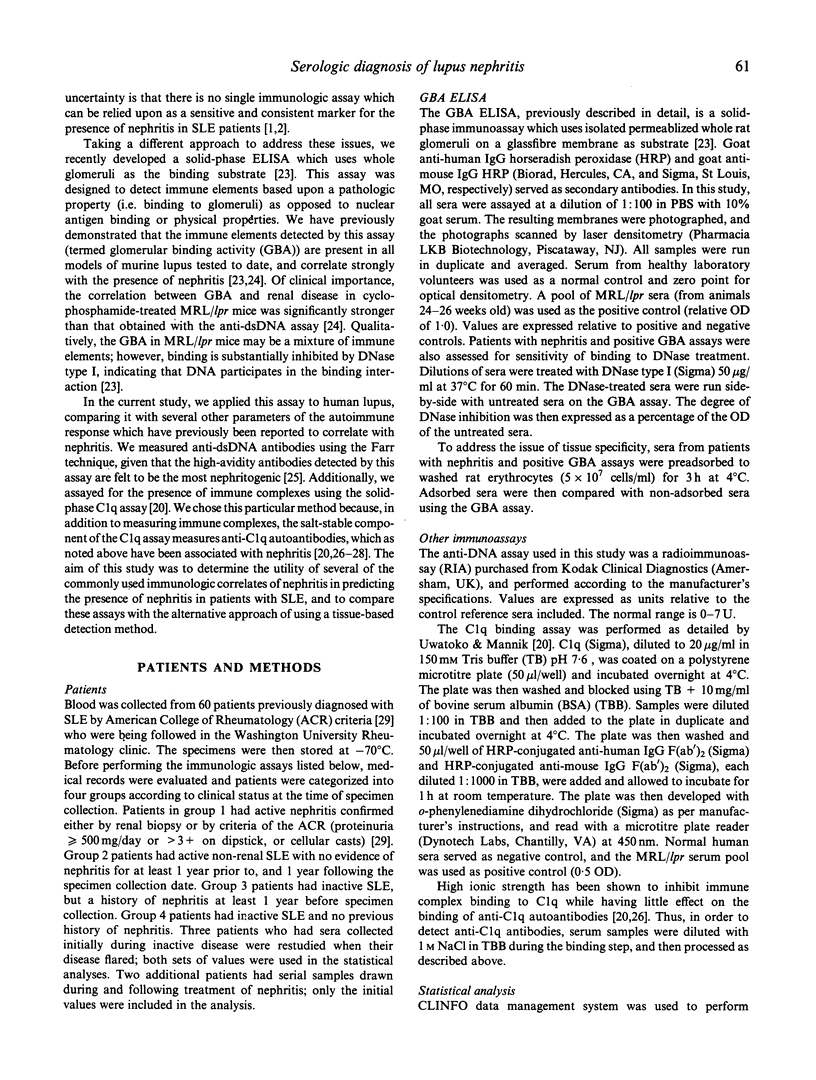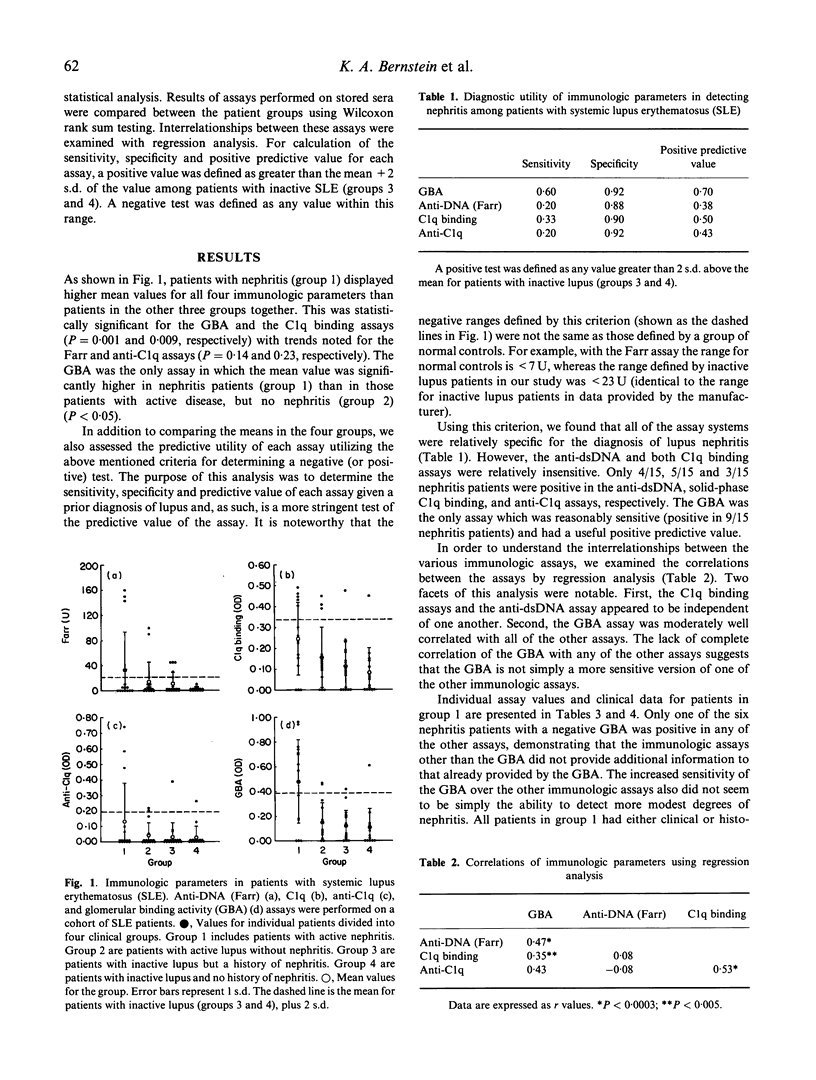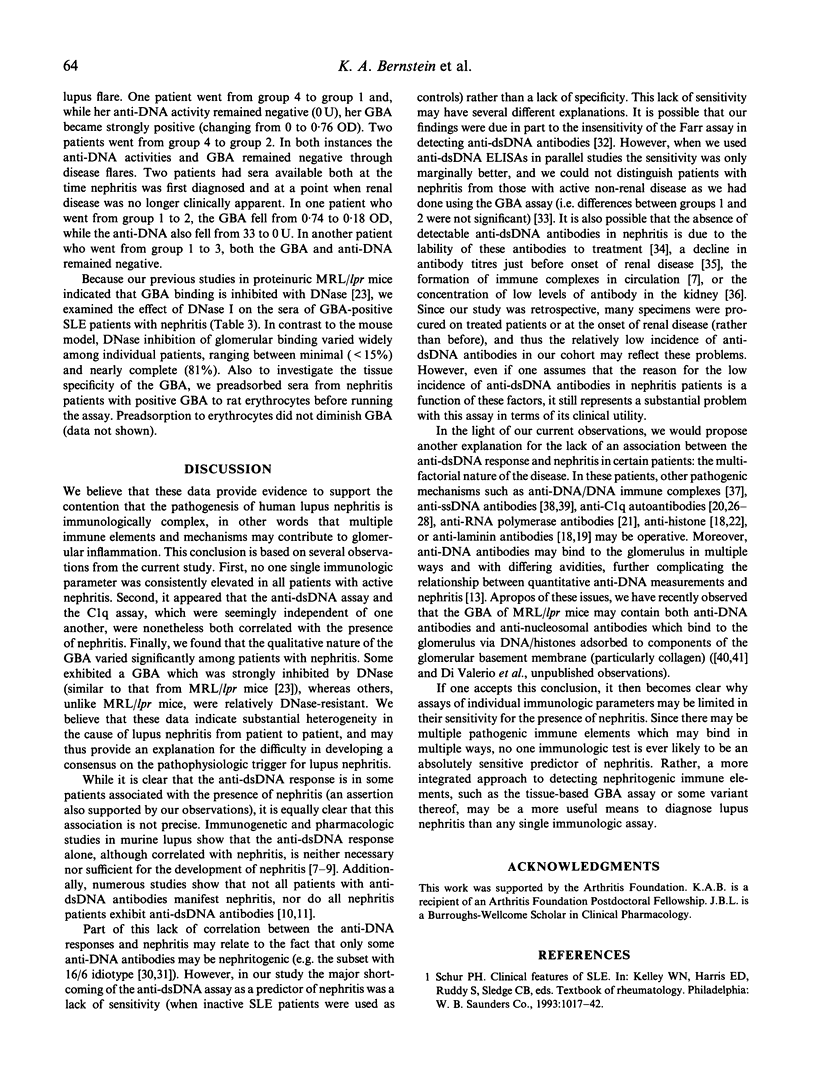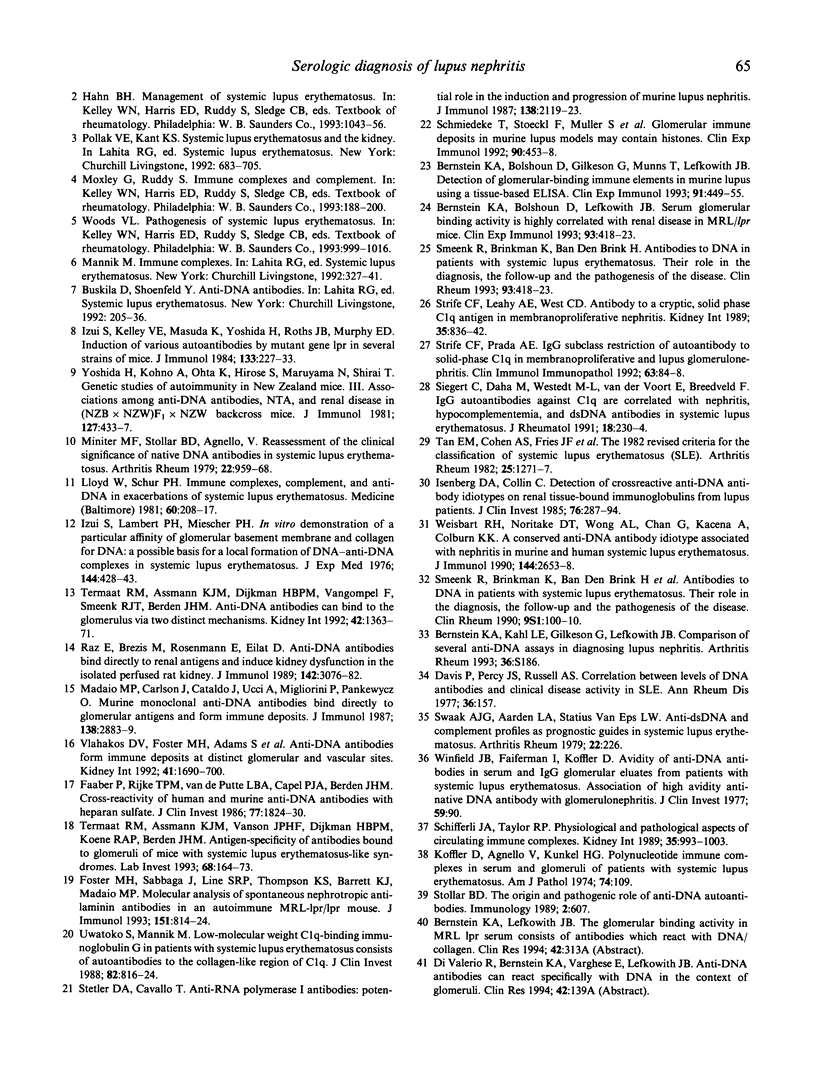Abstract
In order to assess the ability of various serologic assays to correlate with lupus nephritis, we analysed sera obtained from 60 patients with systemic lupus erythematosus (SLE). Patients were categorized as having active nephritis (group 1), active lupus without nephritis (group 2), inactive lupus with prior nephritis (group 3), or inactive lupus without prior nephritis (group 4). Three parameters were assessed including anti-dsDNA antibodies (Farr assay), immune complexes (C1q binding), and anti-C1q antibodies (salt-stable C1q binding). Additionally, glomerular binding activity (GBA) was measured using a new solid-phase immunoassay that detects immune elements by their ability to bind glomerular tissue. We found that patients with nephritis (group 1) exhibited higher mean values for each assay than patients in each of the other three groups (P = 0.001, 0.009, 0.14, and 0.23 in the GBA, C1q, anti-dsDNA, and anti-C1q assays, respectively). The only assay which distinguished patients with nephritis (group 1) from patients having active disease without nephritis (group 2) was the GBA (mean 0.48 +/- 0.09 versus 0.15 +/- 0.04, P < 0.05). In terms of utility, all tests were specific for diagnosing nephritis among patients with lupus; however, only the GBA was reasonably sensitive. The information provided by the anti-dsDNA and C1q assays were not correlated with one another, nor additive to the GBA. Patients with false negative GBA tended to have received more intensive immunosuppression. The qualitative characteristics of GBA varied among patients with nephritis. These data suggest the pathogenesis of lupus nephritis is complex, and may be mediated by an array of immune elements. Moreover, the data indicate the potential utility for a broad tissue-based approach to detection of pathogenic immune elements over other, specific immunologic markers.
Full text
PDF





Selected References
These references are in PubMed. This may not be the complete list of references from this article.
- Bernstein K. A., Bolshoun D., Lefkowith J. B. Serum glomerular binding activity is highly correlated with renal disease in MRL/lpr mice. Clin Exp Immunol. 1993 Sep;93(3):418–423. doi: 10.1111/j.1365-2249.1993.tb08194.x. [DOI] [PMC free article] [PubMed] [Google Scholar]
- Bernstein K., Bolshoun D., Gilkeson G., Munns T., Lefkowith J. B. Detection of glomerular-binding immune elements in murine lupus using a tissue-based ELISA. Clin Exp Immunol. 1993 Mar;91(3):449–455. doi: 10.1111/j.1365-2249.1993.tb05923.x. [DOI] [PMC free article] [PubMed] [Google Scholar]
- Davis P., Percy J. S., Russell A. S. Correlation between levels of DNA antibodies and clinical disease activity in SLE. Ann Rheum Dis. 1977 Apr;36(2):157–159. doi: 10.1136/ard.36.2.157. [DOI] [PMC free article] [PubMed] [Google Scholar]
- Faaber P., Rijke T. P., van de Putte L. B., Capel P. J., Berden J. H. Cross-reactivity of human and murine anti-DNA antibodies with heparan sulfate. The major glycosaminoglycan in glomerular basement membranes. J Clin Invest. 1986 Jun;77(6):1824–1830. doi: 10.1172/JCI112508. [DOI] [PMC free article] [PubMed] [Google Scholar]
- Foster M. H., Sabbaga J., Line S. R., Thompson K. S., Barrett K. J., Madaio M. P. Molecular analysis of spontaneous nephrotropic anti-laminin antibodies in an autoimmune MRL-lpr/lpr mouse. J Immunol. 1993 Jul 15;151(2):814–824. [PubMed] [Google Scholar]
- Isenberg D. A., Collins C. Detection of cross-reactive anti-DNA antibody idiotypes on renal tissue-bound immunoglobulins from lupus patients. J Clin Invest. 1985 Jul;76(1):287–294. doi: 10.1172/JCI111959. [DOI] [PMC free article] [PubMed] [Google Scholar]
- Izui S., Kelley V. E., Masuda K., Yoshida H., Roths J. B., Murphy E. D. Induction of various autoantibodies by mutant gene lpr in several strains of mice. J Immunol. 1984 Jul;133(1):227–233. [PubMed] [Google Scholar]
- Izui S., Lambert P. H., Miescher P. A. In vitro demonstration of a particular affinity of glomerular basement membrane and collagen for DNA. A possible basis for a local formation of DNA-anti-DNA complexes in systemic lupus erythematosus. J Exp Med. 1976 Aug 1;144(2):428–443. doi: 10.1084/jem.144.2.428. [DOI] [PMC free article] [PubMed] [Google Scholar]
- Koffler D., Agnello V., Kimkel H. G. Polynucleotide immune complexes in serum and glomeruli of patients with systemic lupus erythematosus. Am J Pathol. 1974 Jan;74(1):109–124. [PMC free article] [PubMed] [Google Scholar]
- Lloyd W., Schur P. H. Immune complexes, complement, and anti-DNA in exacerbations of systemic lupus erythematosus (SLE). Medicine (Baltimore) 1981 May;60(3):208–217. doi: 10.1097/00005792-198105000-00004. [DOI] [PubMed] [Google Scholar]
- Madaio M. P., Carlson J., Cataldo J., Ucci A., Migliorini P., Pankewycz O. Murine monoclonal anti-DNA antibodies bind directly to glomerular antigens and form immune deposits. J Immunol. 1987 May 1;138(9):2883–2889. [PubMed] [Google Scholar]
- Miniter M. F., Stollar B. D., Agnello V. Reassessment of the clinical significance of native DNA antibodies in systemic lupus erythematosus. Arthritis Rheum. 1979 Sep;22(9):959–968. doi: 10.1002/art.1780220903. [DOI] [PubMed] [Google Scholar]
- Prada A. E., Strife C. F. IgG subclass restriction of autoantibody to solid-phase C1q in membranoproliferative and lupus glomerulonephritis. Clin Immunol Immunopathol. 1992 Apr;63(1):84–88. doi: 10.1016/0090-1229(92)90097-8. [DOI] [PubMed] [Google Scholar]
- Raz E., Brezis M., Rosenmann E., Eilat D. Anti-DNA antibodies bind directly to renal antigens and induce kidney dysfunction in the isolated perfused rat kidney. J Immunol. 1989 May 1;142(9):3076–3082. [PubMed] [Google Scholar]
- Schifferli J. A., Taylor R. P. Physiological and pathological aspects of circulating immune complexes. Kidney Int. 1989 Apr;35(4):993–1003. doi: 10.1038/ki.1989.83. [DOI] [PubMed] [Google Scholar]
- Schmiedeke T., Stoeckl F., Muller S., Sugisaki Y., Batsford S., Woitas R., Vogt A. Glomerular immune deposits in murine lupus models may contain histones. Clin Exp Immunol. 1992 Dec;90(3):453–458. doi: 10.1111/j.1365-2249.1992.tb05867.x. [DOI] [PMC free article] [PubMed] [Google Scholar]
- Siegert C., Daha M., Westedt M. L., van der Voort E., Breedveld F. IgG autoantibodies against C1q are correlated with nephritis, hypocomplementemia, and dsDNA antibodies in systemic lupus erythematosus. J Rheumatol. 1991 Feb;18(2):230–234. [PubMed] [Google Scholar]
- Smeenk R., Brinkman K., van den Brink H., Termaat R. M., Berden J., Nossent H., Swaak T. Antibodies to DNA in patients with systemic lupus erythematosus. Their role in the diagnosis, the follow-up and the pathogenesis of the disease. Clin Rheumatol. 1990 Mar;9(1 Suppl 1):100–110. doi: 10.1007/BF02205557. [DOI] [PubMed] [Google Scholar]
- Stetler D. A., Cavallo T. Anti-RNA polymerase I antibodies: potential role in the induction and progression of murine lupus nephritis. J Immunol. 1987 Apr 1;138(7):2119–2123. [PubMed] [Google Scholar]
- Stollar B. D. The origin and pathogenic role of anti-DNA autoantibodies. Curr Opin Immunol. 1989;2(4):607–612. doi: 10.1016/0952-7915(90)90019-d. [DOI] [PubMed] [Google Scholar]
- Strife C. F., Leahy A. E., West C. D. Antibody to a cryptic, solid phase C1Q antigen in membranoproliferative nephritis. Kidney Int. 1989 Mar;35(3):836–842. doi: 10.1038/ki.1989.61. [DOI] [PubMed] [Google Scholar]
- Swaak A. J., Aarden L. A., Statius van Eps L. W., Feltkamp T. E. Anti-dsDNA and complement profiles as prognostic guides in systemic lupus erythematosus. Arthritis Rheum. 1979 Mar;22(3):226–235. doi: 10.1002/art.1780220304. [DOI] [PubMed] [Google Scholar]
- Tan E. M., Cohen A. S., Fries J. F., Masi A. T., McShane D. J., Rothfield N. F., Schaller J. G., Talal N., Winchester R. J. The 1982 revised criteria for the classification of systemic lupus erythematosus. Arthritis Rheum. 1982 Nov;25(11):1271–1277. doi: 10.1002/art.1780251101. [DOI] [PubMed] [Google Scholar]
- Termaat R. M., Assmann K. J., Dijkman H. B., van Gompel F., Smeenk R. J., Berden J. H. Anti-DNA antibodies can bind to the glomerulus via two distinct mechanisms. Kidney Int. 1992 Dec;42(6):1363–1371. doi: 10.1038/ki.1992.428. [DOI] [PubMed] [Google Scholar]
- Termaat R. M., Assmann K. J., van Son J. P., Dijkman H. B., Koene R. A., Berden J. H. Antigen-specificity of antibodies bound to glomeruli of mice with systemic lupus erythematosus-like syndromes. Lab Invest. 1993 Feb;68(2):164–173. [PubMed] [Google Scholar]
- Uwatoko S., Mannik M. Low-molecular weight C1q-binding immunoglobulin G in patients with systemic lupus erythematosus consists of autoantibodies to the collagen-like region of C1q. J Clin Invest. 1988 Sep;82(3):816–824. doi: 10.1172/JCI113684. [DOI] [PMC free article] [PubMed] [Google Scholar]
- Vlahakos D. V., Foster M. H., Adams S., Katz M., Ucci A. A., Barrett K. J., Datta S. K., Madaio M. P. Anti-DNA antibodies form immune deposits at distinct glomerular and vascular sites. Kidney Int. 1992 Jun;41(6):1690–1700. doi: 10.1038/ki.1992.242. [DOI] [PubMed] [Google Scholar]
- Weisbart R. H., Noritake D. T., Wong A. L., Chan G., Kacena A., Colburn K. K. A conserved anti-DNA antibody idiotype associated with nephritis in murine and human systemic lupus erythematosus. J Immunol. 1990 Apr 1;144(7):2653–2658. [PubMed] [Google Scholar]
- Winfield J. B., Faiferman I., Koffler D. Avidity of anti-DNA antibodies in serum and IgG glomerular eluates from patients with systemic lupus erythematosus. Association of high avidity antinative DNA antibody with glomerulonephritis. J Clin Invest. 1977 Jan;59(1):90–96. doi: 10.1172/JCI108626. [DOI] [PMC free article] [PubMed] [Google Scholar]
- Yoshida H., Kohno A., Ohta K., Hirose S., Maruyama N., Shirai T. Genetic studies of autoimmunity in New Zealand mice. III. Associations among anti-DNA antibodies, NTA, and renal disease in (NZB x NZW)F1 x NZW backcross mice. J Immunol. 1981 Aug;127(2):433–437. [PubMed] [Google Scholar]


